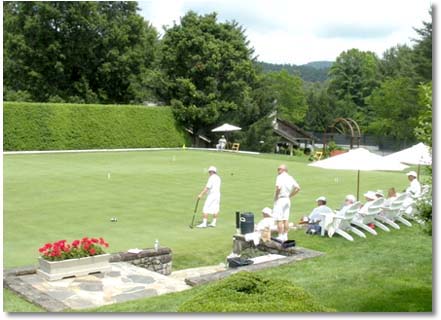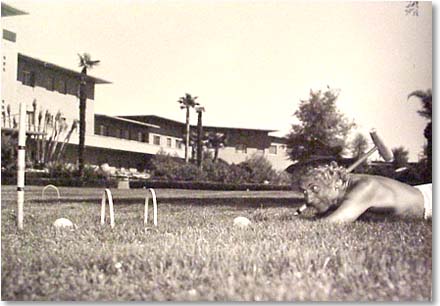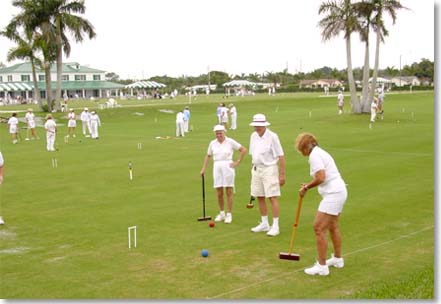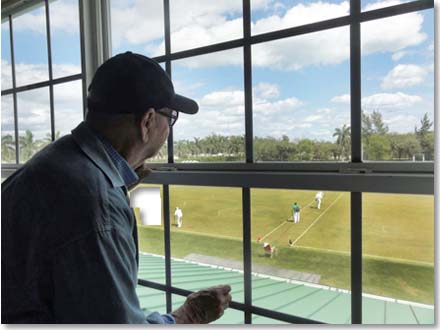
|
Back to |
| The Front Page |
| The Game |
|
Can both Golf Croquet and Association Croquet find space to play in peace? |
||||||
|
by Bob Alman, photos as attributed
|
||||||
|
||||||
American editor Bob Alman actually implemented the proposed solution in 2002 in West Palm Beach, as the organizing manager of the National Croquet Center, before anyone was pointing to a "problem." His successor as manager canceled after only three years more than one hundred half-court limited play Golf Croquet memberships, one of the main elements of his development plan. That was a mistake. However, the many-faceted success of that membership can now be referenced as Exhibit One in proposing a membership of the same kind for consideration by every croquet club in America: a Limited Half-Court Golf Croquet Membership, priced as all dues should be priced--in proportion to the privileges accorded--and subject to change, with changing local priorities. (Throughout this article, "AC" will be understood to mean both Association Croquet and American Rules.)
The United States Croquet Association was delighted to find, less than a decade ago, that promoting Golf Croquet in the North Carolina Western highlands was an enormous success at more than ten country clubs in close proximity. They all became affiliate clubs of the USCA. One president of the USCA, Gene Young, a North Carolinian himself, devoted his presidency to making it happen.
The croquet membership activities are well known to all the clubs, who compete for country club members, most of whom are seasonal residents in the summer. [See "Golf Croquet Spreads like Wildfire in the Mountain of North Carolina.]
Just a few country clubs in North Carolina had croquet courts ten years ago. Now more than a dozen have thriving croquet programs, and the croquet players compete against each other along a 30-mile stretch of highway stretching from Lake Toxaway in the east to Highlands in the west. Croquet was such a hit that the croquet groups expanded in size, and courts had to be added to accommodate the players. (Which means that the solution we propose could help those country clubs as well.)
Country club management loves the game--and the fact that it takes up so much less space than golf in that mountainous terrain. The players love it. And the USCA loved it--at first.

|
| "The Chattooga club in North Carolina managed to build two full courts on their mountainous terrain. Don Oakley photo." |
The down side of all this fortuitous happenstance was soon revealed to the USCA. Very few of those players took up the more "advanced" and familiar form of croquet promoted by the national organization, and by most of the national associations in the world. Those whose memberships had been included in their first year found no sufficient reason to pay for a continuing USCA individual membership. So the USCA gets very little income from those players. The main benefit to the national organization is from the relatively few Golf Croquet players who take up the more complex forms of the sport.

|
| Harpo Marx enjoyed taking a ridiculously silly game seriously in his back yard. |
Similar movement away from the more complex forms of the sport is reported from almost every country in the world. Tony Hall reports that the "danger" of social Golf Croquet is more apparent in some of the Australian states and regions than others. South Africa is reported to have been virtually overtaken by Golf Croquet, with no Association Croquet at all played in many clubs. New Zealanders have--perhaps--achieved a better balance between AC and GC than most other countries. And Egypt, which gave the croquet world Golf Croquet, plays virtually no Association Croquet.
What is the role of the national organizations in this crisis?
England commissioned a study. It's initial conclusion struck me as rather murky. I got the impression that many if not most "serious" players of Association Croquet believe either that Association Croquet should be the focus of the first lesson, or that only the "intellectual class" should be encouraged to play croquet.

|
| This is how serious competitive croquet looks in England at the Surbiton club. |
In the last several years a persisting conversation in USCA management has been, "How can we provide sufficient value to the social Golf Croquet players to have them join and support the USCA?" And a related question has been, "How can we advise the serious competitors in local clubs who are worried about the huge success of Golf Croquet--possibly to the detriment of the traditional and much more complex form?"
Half-court limited Golf Croquet made perfect sense
It was a no-brainer for the first manager of the National Croquet Center, at the beginning of the century. The facility was new and unknown to the larger public, which needed to be invited to an every-Saturday free Introduction to Croquet. Naturally, the game was Golf Croquet, played on half-courts. That has been general practice in America and much of the croquet world, in the 21st Century, on either full courts or half-courts.
The half-courts we chose for our public Introduction to Croquet were the ones directly off the south veranda, adjacent to the bar. The same half-courts could be used regularly for casual groups of visitors and private corporate parties centered on the bar. They are still used for the same purpose.

|
| This is what a Half-Court Limited Golf Croquet membership looks like. In early 2002 at the National Croquet Center, these social players are having a great time on the Palm Courts, split into half-court size. They do not appear to feel stigmatized in comparison with the full-court players in the background, playing on the facility's 12 regulation courts. This area--coded as a dry retention area--is slated to be restored within the next year to accommodate three full-sized courts and additional smaller ones. The restoration and expansion will make the National Croquet Center in West Palm Beach arguably not only the most beautiful facility in the world, but also the largest in full-size court capacity. |
It seems odd to me, though, that individuals or couples who learn Golf Croquet on half-courts at the Center are not today given a chance to buy a half-court membership for Golf Croquet.
The Social Membership the Center offers does allow both full-court games of any kind on Saturday afternoons and for a Thursday evening Twilight Croquet gathering with bar and food service, similar to my proposal. But it takes up twice as much court space in "prime time" and costs almost twice as much as the proposed cost of a half-court limited Golf Croquet membership.

|
| Casual ecclesiastic croquet on a half-court looks like this. Illustration by Bill Sweeney. |
This leaves room for improvement, in my view, since the National Croquet Club is vitally concerned about having enough space to play for themselves, as they already occasionally have to compete for space with corporate and private parties, as well as for USCA and other tournaments. (It should be noted, however, that the Club is completely separate from the Croquet Foundation and the Center, and only shares the Center's facilities. Those competing uses help keep their membership cost to about 1/3 of the total operating cost of the Center.)
Croquet needs to welcome younger and working people
When I asked my successor as manager, Mike Jenner, why he eliminated in 2004 my half-court limited Golf Croquet Membership--with more than 100 members--he said, "They could join as full members." Yes, they would have that choice at a much higher cost, but in fact very few of them did. Many of them had been as much or more interested in being a member of the club for the bar, the dining, the parties, the hanging out, as for the Golf Croquet. So that decision effectively hobbled the growth of the club for years to come.
| BUYING LEVELS OF PRIVILEGE WITH YOUR CLUB MEMBERSHIP |
|
This proven scheme embraces a free-market scheme of club membership: the more you want, the more you pay, the more you get. It welcomes "social players" of Golf Croquet as well as Association Croquet players at all levels of play, and permits members to play either or both. Details are dependent on the number of courts and existing amenities in any given local club. Full days or half days may be calendared in three or more membership categories, in ascending order of cost/privileges:
(1) Half-court Golf Croquet at limited playing times.
(2) Full-court Association Croquet at any time calendared.
(3) "Full membership" allowing full access to any category of play scheduled: half-courts, full courts, Golf Croquet, or Association Croquet.
The pricing of membership dues can be changed or adjusted annually to reflect the current "market" value" of playing space and the aspirations of the club.
|
The playing times were chosen to support bar and dining and encourage people who work in offices, with regular and normal office hours. One period was on Saturday afternoons beginning at 1:00 PM--allowing them to come to the buffet lunch first; another was on Thursday after 4:00 PM, encouraging them to come to the "twilight croquet" evening at the bar, with dining options. Because they were interested mostly in the social aspect of the club, they brought guests for the bar, dining, and club parties out of all proportion to their numbers.
It will be said--truly--that most croquet clubs do not have the features that would best draw "social" members--the bar, the dining, the parties; or if they do, they are associated with and benefit the host country club and not the croquet club, per se. However, the "volunteer" culture of the clubs of England, it seems to me, already gives them a clubby atmosphere. Their "social" members could include food and drink with their limited half-court playing privileges, and organize it themselves. They might even enjoy helping out with maintenance.
So why not find out how it would work, by creating a membership class that would work for them as well as for the other players and the club?
Who will take a stand and make this happen?
I will, for one. The timing is right. Our local members club is rightly worried about having enough playing space for members. That concern can be addressed by reminding the club that they can change the parameters of a membership--the price, the limitations and privileges--at any time. Their goal should be to have a lot of members in different categories, with a range of prices and privileges.

|
| At a large club, one can find a way to to view both "serious" and "casual" croquet at the same time. Photo by Bob Alman. |
The president of the USCA is already engaged in a conversation that ultimately could embrace the entire spectrum of USCA clubs, from one-court to 10-court public or country clubs. I have been invited to write an article about it for the USCA; this is that article.
The story to be adapted from this one for the USCA's publication for members will probably include photographs and a play-by-play description of a "serious" game of Golf Croquet played by decent (and well-known) players on half-courts. I'm looking forward to being included in this game, and I maintain that it will be very interesting--more interesting, in some ways, than full-court play. (I'm predicting lots of hoop attempts from the boundary!) Ideally, the president of the USCA, the president of the Croquet Foundation, and a croquet pro would be the players. The USCA president and myself would be the weaker players on each team.
Half courts double the efficiency of the available space; and the adjustable "limitation" is the allowed times of play, Membership prices could also be adjusted to suit "the market" locally.
It's already been proven to work!
Since the Jenner days, I have lobbied for restoring the Center's Dry Retention Area (allowed to degrade in a period of financial crisis) behind the regulation lawns with good irrigation and grass. That huge expanse of grass (recently designated "The Palm Courts") was in the beginning a gorgeous multi-sports area used often for half-court Golf Croquet on Bermuda 419 cut to one-half inch--a perfect grass for novices, who haven't learned yet how to regulate the speed of the ball.

|
| Serious competitive croquet can be viewed from a drone at the Dallas Croquet Club. Photo courtesy of Bob Chilton. |
I asked a wealthy friend to give her annual donation to the Foundation with the proviso that it all be committed to the restoration of that area. The president of the Foundation expects to complete its restoration with three or four full-sized courts by the middle of 2019, making the NCC truly "the biggest croquet facility in the world" (with 15 full-size regulation courts and additional ones of smaller size), I'm hoping this will relieve the anxiety of the club about having sufficient court space for the "full members" to play on. We shall see.
Who else will pioneer this solution?
But other clubs--clubs everywhere, all around the world--don't have to wait to institute this reform and at least address the issue in an effective way, to ease the territorial crisis threatening the sport. Half courts are TWICE as efficient as full courts, and for Golf Croquet, they can even be tripled banked when necessary.
| MANAGING TIME AND SPACE IN GOLF |
|
The shorter course in golf is often called the Executive Course--implying that executives don't have a lot of time for games. Younger people look for immediate gratification in a golf game played at 2200 yards instead of the more traditional length of 7200 yards. Both groups are looking for a game as authentic as possible, done quickly. You make the same moves--in less time, over shorter space. The first "Open" in Great Britain was played on a twelve-hole course. Since then, players have gotten the idea that bigger is better; but it's not true, and owners are learning to market the sport to people who value their time. Golf, like croquet, is a game of balance, dexterity, touch, feel and strategy. The display of skill that distinguishes good play does not require a lot of territory--or time.
Jack Saffold, PGA
|
At the least, the USCA will recommend and demonstrate to local clubs the workability of the Half-Court Limited Golf Croquet Membership. USCA management will consider a "secondary" class of membership whose smaller membership price will actually be justified--because the costs (in the US) of staff time for tabulating the results of every game into a system that ultimately awards handicaps and rankings will have been eliminated for social players.
"Social players"--defined as players who don't compete in sanctioned tournaments--actually comprise almost two-thirds of the USCA's membership. That's a huge percentage, as compared to other sports, including tennis. (The tennis equipment of half-court play, incidentally, is called "Pickle-ball," now a fast-growing American sport, enabling older players to cover the court in competitive games.)
The territorial imperatives of golf do not apply in the sport of croquet. Croquet is a game of space, not territory. We can make the space for croquet--in all it's forms--to succeed for everyone. "Everyone" should finally include the majority of croquet players, anywhere in the world.
Bob Alman is the founding editor of this magazine. He lived and worked in Manhattan and San Francisco for many years and was hired in 1999 by Chuck Steuber to organize and manage the National Croquet Center. Since July of 2003 he has remained in West Palm Beach, volunteering for the National Croquet Center and the USCA in various roles. His favorite activity is teaching croquet to novices every Saturday morning at the National Croquet Center. He recommends to readers who crave more detailed expert opinion on this subject "Golf Croquet: Benefit or Bane?" published in 2012, with Chris Clarke, Tony Hall, Louis Nel, and Martin French.